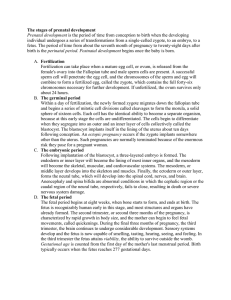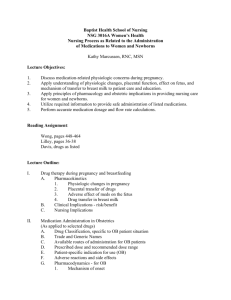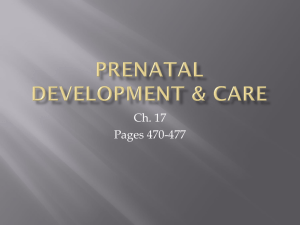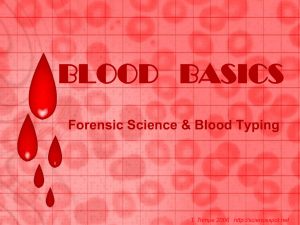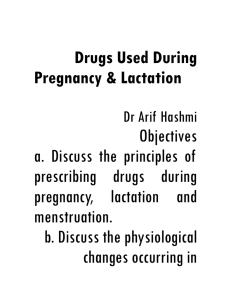Forming a new Life - St. Edwards University
advertisement
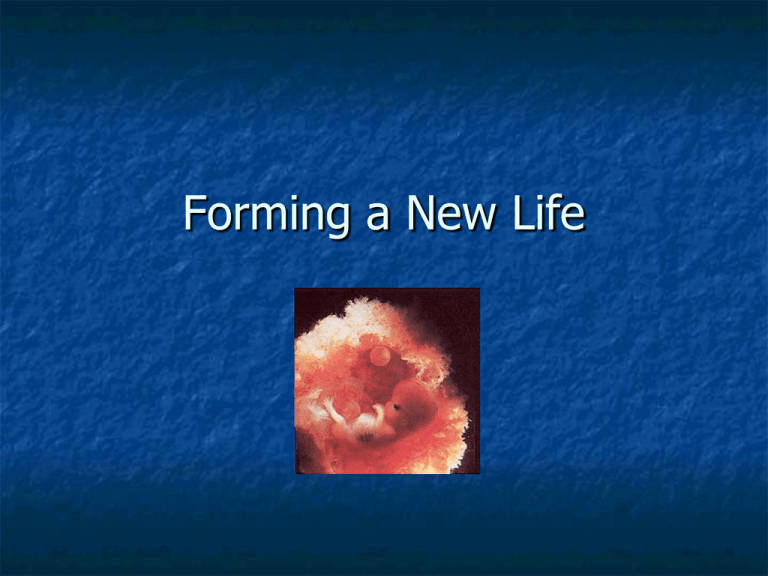
Forming a New Life MOTIVATIONS FOR PARENTHOOD Why Have Children? In the past, biologically & culturally expected Now, decisions influenced by birth control techniques and changing social values Advantages of parenthood: Giving and receiving warmth & affection Experiencing growth & learning opportunities Having others carry on after your death Sense of accomplishment How Large a Family? In 1960, average # of children = 3.1; today = 1.8 in U.S. Smaller family size more compatible with women’s decision to have both family & career Children can benefit from smaller families… Large families economically disadvantaged Only children just as well adjusted as children with siblings Is There a Best Time to Have a Child? First births to women in 30’s increased greatly over past two decades Advantages of older parents Financially More mature Procrastination could lead to fertility problems because of age Becoming Parents: How Conception Occurs Conception How Fertilization Takes Place Sperm and ovum– the male and female gametes (sex cells)– combine to create a zygote Zygote will duplicate itself by cell division to create a baby Conception How Fertilization Takes Place Girls have about 2 million ova in their ovaries at birth, each contained in a follicle During ovulation, a mature follicle is ruptured and expelled from the ovary Ovum is swept through the fallopian tube toward the uterus Conception How Fertilization Takes Place Several hundred million sperm are produced in the testicles each day Sperm enter the vagina through ejaculation and attempt to reach the cervix; eventually a few will arrive in the fallopian tubes where fertilization takes place Infertility The inability to conceive a child after a year of unprotected intercourse or the inability to carry a child to term Fertility issues are equally distributed among men and women 1% of children in U.S. are the product of assisted fertility Infertility Inability to Conceive a Baby After 12 Months of Trying 7 Percent of U.S. Couples are Infertile Women’s Fertility Begins to Decline in the Late 20s Men’s Fertility Begins to Decline in the Late 30s Infertility Causes of Infertility Men Too few sperm; 60-200 per ejaculation is too low Duct may be blocked, or sperm are unable to “swim” well enough Infertility Causes of Infertility Women Blockage in the fallopian tube Failure to produce ova or good quality ova Mucus in the cervix Disease in the uterine lining Infertility Treatments For Infertility Hormone treatment Drug therapy Surgery PRENATAL DEVELOPMENT The Period of the Zygote Lasts about 2 weeks – from fertilization until cell mass attaches to uterine wall By 4th day, 60-70 cells form blastocyst As many as 30% of zygotes do not make it through the implantation phase Placenta – permits food & oxygen to reach embryo and waste to be carried away Umbilical cord – connects the placental to the developing organism The Period of the Embryo Lasts from implantation to the 8th week of pregnancy Most rapid prenatal changes occur during these 6 weeks During this period, groundwork for all body structures and organ development begins; digestive/circulatory systems Toward end of this period, embryo can move! The Period of the Fetus “growth and finishing” stage – lasts until end of pregnancy Incorporates end of 1st trimester, 2nd & 3rd trimesters By middle of 2nd, mom can feel movement; fetus can be irritated sounds & light By 3rd, cerebral cortex enlarges, fetus spends more time awake Around 24 weeks, fetus can feel pain By end of term, fetus moves less often due to space constraints Higher fetal activity during last weeks predicts more active infant in first month of life The Period of the Fetus Age of Viability – (22-26 weeks) the point at which the fetus can first survive if born early If born b/w months 7-8, usually needs oxygen assistance to breathe In the last weeks, most fetuses move into upside-down position and growth slows… GETTING READY FOR THE JOURNEY! PRENATAL ENVIRONMENTAL INFLUENCES Complications of Pregnancy and Dangers to the Fetus Effects of teratogens Substances that cause defects in embryonic and fetal development Infectious diseases German Measles (rubella) Group B streptococcus Complications of Pregnancy and Dangers to the Fetus Pregnancy after age 35 Is more common as women wait to have children Increased likelihood of chromosomal variation Risk increases with increasing maternal age Complications of Pregnancy and Dangers to the Fetus Sexually transmitted infections Can be transmitted from pregnant woman to fetus, newborn, or infant Chlamydia Gonorrhea Hepatitis B HIV Syphilis Genital herpes Complications in Pregnancy Ectopic pregnancy Pregnancy-induced hypertension Premature births Delayed labor Diagnosing Abnormalities of the Fetus Ultrasound Amniocentesis Chorionic villus sampling (CVS) Alpha-fetoprotein (AFP) screening Ultrasound High frequency sound waves determine size and position of fetus Sonogram—picture Estimates fetal age, guides during amniocentesis, checks for physical birth defects, evaluates complications during pregnancy
